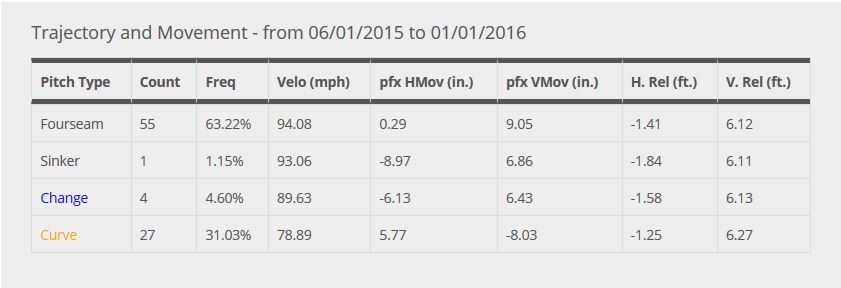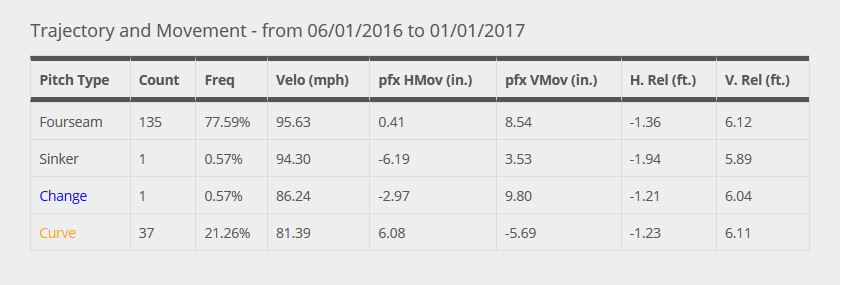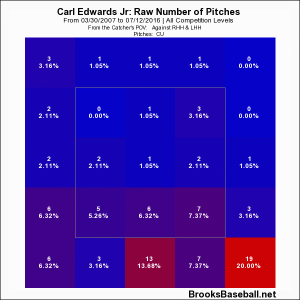After Carl Edwards Jr.’s 2014 was shortened by inflammation in his pitching shoulder, the Cubs made a decision to move him to the bullpen–at least for the short-term. The theory, as general manager Jed Hoyer explained to the Chicago Tribune’s Mark Gonzales, was that moving to the ‘pen would help the former number 81 prospect in all of baseball get to the big leagues quicker than remaining in the rotation.
“He looked outstanding this spring,” general manager Jed Hoyer said of Edwards, 23, the Cubs’ top pitching prospect. He was right: Edwards was not scored upon in two major league spring appearances. “We used him in a bunch of relief outings, and his stuff was electric. Certainly maybe it’s a quicker path into the big leagues as a reliever.”
“We certainly in no way, shape, or form, have given up on him as a starter. But we also realize we got to manage his innings a little bit this year and start him off in that role allows us to do that, and then make an assessment which way we want to go with him.”
The Cubs’ thin right-handed pitching prospect came up for two stints in the bullpen last season, but in his 4 2/3 inning sample didn’t look like he had the command to be pitching in the big leagues. Although many thought he had a great shot at breaking camp with the Cubs this year in the bullpen, he again had to go to Triple-A to prove his ability.
Fast forward, and Edwards finally looks like he might stick in the big leagues. Joe Maddon is trusting him to pitch the eighth inning of a one-run game when the team is in its worst stretch of the season and badly needing a victory. So why, all of the sudden, are the Cubs treating Edwards like he’s one of the best relievers on the roster?
Part of it is command. In yet another small sample, but an important one, Edwards’ walks are down. Last season, pitching in Double-A, Triple-A, and the major leagues, Edwards walked 44 batters in 60 total innings. Even with the 79 strikeouts he compiled, that number was way too high to seriously consider him a viable option in the bullpen. But with the Cubs in 10 2/3 innings this season, he’s walked just three batters while striking out 12 and allowing four hits.
At a time when the pitching staff can’t stop walking batters and giving up home runs, Edwards’ hard fastball and big curveball are nice to have available in reserve. Again, it’s a small sample size, but it’s worth dissecting how things have been different with Edwards from his two stints in 2015 to the job he’s done this year, according to Brooks Baseball.
Here we see that he threw primarily his fastball and curveball in 2015, with the fastball averaging around 94 mph. But when you look at the pitches thrown this season, you’ll notice some key differences.
The velocity on both of his major pitches are both up a bit, and that’s key. The fastball velocity is up from 94 to 95.6, but in addition he’s using the hard, 95-mph fastball quite a bit more frequently this season than he has in the past. And that’s where I believe his value lies.
Edwards’ curveball has plus potential, but so far in his young career it has been slightly inconsistent. In his major league career, he’s only been able to throw 28.4 percent of his curveballs in the strike zone.
This would be fine, if he were deceiving batters and getting a ton of swing-and-miss against the pitch. But in reality, Edwards is doing much better with his fastball in that regard. He’s getting more swings, more whiffs, and has far better command of his four-seamer—getting 40.3 percent of them over the plate and in the zone.
If he can continue pitching in this way, with more fastballs and less curveballs—or, to simplify it, more strikes and less balls—then I believe Edwards can make himself a nice role in the Cubs bullpen.
In addition to command, confidence is another big plus for Edwards. As in, the Cubs are confident in him and he’s confident in himself. Right now, it’s making him a difference maker. The Cubs bullpen has been a mess lately, with the month-by-month ERA going from 2.72 in April to 3.80, 3.96, and then 5.85 so far in July. Here is a little bit of a glimpse into the Cubs’ relief options and their performance since Edwards’ first appearance on June 22nd.
You wouldn’t expect pitchers such as Pedro Strop, Trevor Cahill, and Travis Wood to struggle to this extreme over a long stretch. But Spencer Patton is unreliable and the inconsistencies of Justin Grimm have become a real problem. It’s been a part of why the Cubs have had what amounts to open tryouts for any pitcher on their 40-man roster. Edwards seems to be the only one, so far, that’s grabbed onto his spot in the big league with both hands.
With the Cubs rumored to be interested in bullpen arms that they could acquire in the next few weeks prior to the trade deadline, Edwards stands in an important position. If he can continue to throw strikes, gain Maddon’s trust, and provide a quality option in middle relief, a trade for another quality reliever could transform a group that has been pretty bad as a collective since April into one of the deepest bullpens in the National League.
Lead photo courtesy David Kohl—USA Today Sports.




